I haven't provided detailed commentary on the US labour market for a while now. To…
Australian labour market – unemployment rate higher than in crisis
Today’s release of the – Labour Force data – for June 2014 by the Australian Bureau of Statistics is slightly improved on recent months but still portrays a weak labour market. While the participation rate rose, which pushed extra workers into the labour force, employment growth still remained below population growth and so unemployment would have risen without the participation rate rise. The other poor outcome was the decline in full-time employment. Overall, the labour market is scudding along a very flat path and unemployment continues to eke its way up. The unemployment rate topped 6 per cent in June 2014 and is now higher than it was 5 years ago (June 2009) when the worst of crisis was being endured before the fiscal stimulus took effect. That symbolises policy failure.
The summary ABS Labour Force (seasonally adjusted) estimates for June 2014 are:
- Employment increased 15,900 (1.0 per cent) with full-time employment decreasing by 3,800 and part-time employment rising by 19,700.
- Unemployment increased by 20,300 to 741,700.
- The official unemployment rate rose by 0.1 points to 6.0 per cent.
- The participation rate rose by 0.1 percentage points to 64.7. It is still well below its November 2010 peak (recent) of 65.9 per cent.
- Aggregate monthly hours worked increased by 15.1 million hours (0.9 per cent).
- The quarterly ABS broad labour underutilisation estimates (the sum of unemployment and underemployment) were published in the May release and underemployment rose by 0.2 percentage points to 7.6 per cent and total labour underutilisation rate was 13.5 per cent. There were 936.59 thousand persons underemployed. The total workers unemployment or underemployed is now 1.653 million.
Employment growth – barely visible
The data for June show that employment growth continues to creep along the zero line, continuing the trend that has prevailed for the last 24 or so months.
Total employment rise by 15,900 (1 per cent) with full-time employment contracting by 3,800 and part-time employment rising by 19,700.
Over the last 24 months or so we have seen the labour market data switching back and forth regularly between negative employment growth and positive growth spikes. This month’s figure, however, is the strongest overall performance in that time.
The following graph shows the month by month growth in full-time (blue columns), part-time (grey columns) and total employment (green line) for the 24 months to June 2014 using seasonally adjusted data. It gives you a good impression of just how flat employment growth has been.
While full-time and part-time employment growth are fluctuating around the zero line, total employment growth is still well below the growth that was boosted by the fiscal-stimulus in the middle of 2010.
The following table provides an accounting summary of the labour market performance over the last six months. The monthly data is highly variable so this Table provides a longer view which allows for a better assessment of the trends. WAP is working age population (above 15 year olds).
The conclusion – overall there have 110.7 thousand jobs (net) added in Australia over the last six months. Full-time employment has risen by 94.8 thousand jobs (net) while part-time work has risen by only 15.9 thousand jobs.
The Working Age Population has risen by 173 thousand in the same period while the labour force has risen by 138.6 thousand. The participation rate has risen by 0.141 percentage points over the last six months.
The weak employment growth has thus not been able to keep pace with the underlying population growth and unemployment has risen by 28 thousand as a result.
The rise in unemployment would have been worse had the participation rate not dropped (see below).
Today’s data is consistent with the very weak trends that have ruled for a long period now.
To put the recent data in perspective, the following graph shows the movement in the labour force and total employment since the low-point unemployment rate month in the last cycle (February 2008) to June 2014. The two series are indexed to 100 at that month. The green line (right-axis) is the gap (plotted against the right-axis) between the two aggregates and measures the change in the unemployment rate since the low-point of the last cycle (when it stood at 4 per cent).
You can see that the labour force index has largely levelled off yet the divergence between it and employment growth has risen sharply (in spurts) over the last several months.
The Gap series gives you a good impression of the asymmetry in unemployment rate responses even when the economy experiences a mild downturn (such as the case in Australia). The unemployment rate jumps quickly but declines slowly.
It also highlights the fact that the recovery has not strong enough to bring the unemployment rate back down to its pre-crisis low. You can see clearly that the unemployment rate fell in late 2009 and then has hovered at the same level for some months before rising again over the last several months.
The Gap shows that the labour market is now in worse shape than it was at the peak of the financial crisis in 2009. After the government prematurely terminated the fiscal stimulus the situation has progressively deteriorated.
In fact, in June 2014, the Gap (2.2 percentage points) exceeded the levels that appeared in May and June 2009 when the Australian economy was enduring the impact of the crisis. All the gains made since then have thus largely disappeared due to poorly crafted fiscal policy not responding appropriately to non-government spending changes.
There is a slight upward bias in the unemployment rate.
Full-time and Part-time employment in recovery
The following graph shows employment indexes for the last 3 recessions and allows us to see how the trajectory of total employment after each peak prior to the three major recessions in recent history: 1982, 1991 and 2009 (the latter to capture the current episode).
The peak is defined as the month of the low-point unemployment rate in the relevant cycle and total employment was indexed at 100 in each case and then indexed to that base for each of the months as the recession unfolded.
I have plotted the 3 episodes for 76 months after the low-point unemployment rate was reached in each cycle. The current episode is now in its 76th month.
The initial employment decline was similar for the 1982 and 1991 recessions but the 1991 recovery was delayed by many month and the return to growth much slower than the 1982 recession.
The current episode is distinguished by the lack of a major slump in total employment, which reflects the success of the large fiscal stimulus in 2008 and 2009.
However, the recovery spawned by the stimulus clearly dissipated once the fiscal position was reversed and the economy is now producing very subdued employment outcomes.
Moreover, the current episode is also different to the last two major recessions in the sense that the recovery is over and the economy is deteriorating again.
The next 3-panel graph decomposes the previous graph into full-time and part-time employment. The vertical scales are common to allow a comparison between the three episodes.
First, after the peak is reached, part-time employment continues to increase as firms convert full-time jobs into fractional jobs.
Second, recoveries are dominated by growth in part-time employment as firms are reluctant to commit to more permanent arrangements with workers while there is uncertainty of the future course in aggregate demand.
Third, the current recovery is clearly mediocre by comparison, with both very subdued growth in full-time and part-time work.
Teenage labour market – some employment growth
Full-time employment for teenagers fell by 7.4 thousand in June 2014, while part-time employment rose by 25.4 thousand. Overall, teenage employment rose by 18.1 thousand in June 2014. A month of positive growth in teenage employment is rare these days and is welcome, even though it was associated with further declines in full-time opportunities.
The following graph shows the distribution of net employment creation in the last month by full-time/part-time status and age/gender category (15-19 year olds and the rest)
If you take a longer view you see how poor the situation is.
Over the last 12 months, teenagers have lost 12.9 thousand jobs while the rest of the labour force have gained 113.2 thousand net jobs. Remember that the overall result represents a very poor annual growth in employment.
Even more disturbing is the attrition of full-time jobs among teenagers – losing 4.2 thousand over the last year.
The teenage segment of the labour market is being particularly dragged down by the sluggish employment growth, which is hardly surprising given that the least experienced and/or most disadvantaged (those with disabilities etc) are rationed to the back of the queue by the employers.
The following graph shows the change in aggregates over the last 12 months.
To further emphasise the plight of our teenagers, I compiled the following graph that extends the time period from the February 2008, which was the month when the unemployment rate was at its low point in the last cycle, to the present month (June 2014). So it includes the period of downturn and then the so-called “recovery” period. Note the change in vertical scale compared to the previous two graphs.
Since February 2008, there have been only 930.7 thousand (net) jobs added to the Australian economy but teenagers have lost a staggering 97.4 thousand over the same period. It is even more stark when you consider that 104.5 thousand full-time teenager jobs have been lost in net terms.
Even in the traditionally, concentrated teenage segment – part-time employment, has only added 7.1 thousand jobs (net) even though 509.2 thousand part-time jobs have been added overall.
Overall, the total employment increase is modest. Further, around 55 per cent of the total (net) jobs added since February 2008 have been part-time, which raises questions about the quality of work that is being generated overall.
To put the teenage employment situation in a scale context the following graph shows the Employment-Population ratios for males, females and total 15-19 year olds since March 2008 (the month which coincided with the low-point unemployment rate of the last cycle).
You can interpret this graph as depicting the loss of employment relative to the underlying population of each cohort. We would expect (at least) that this ratio should be constant if not rising somewhat (depending on school participation rates).
The facts are that the absolute loss of jobs reported above is depicting a disastrous situation for our teenagers. Males, in particular, have lost out severely as a result of the economy being deliberately stifled by austerity policy positions.
The male ratio has fallen by 10.3 percentage points since February 2008, the female by 5.3 percentage points and the overall teenage employment-population ratio has fallen by 7.9 percentage points.
The ratios improved slightly this month on the back of the rise in part-time employment.
Overall, the performance of the teenage labour market continues to be deeply disturbing. It doesn’t rate much priority in the policy debate, which is surprising given that this is our future workforce in an ageing population. Future productivity growth will determine whether the ageing population enjoys a higher standard of living than now or goes backwards.
The longer-run consequences of this teenage “lock out” will be very damaging.
The problem is that in the modest growth period that the Australian labour market enjoyed as a result of the fiscal stimulus and mining investment, teenagers failed to participate in the gains – they went backwards.
While this month has shown some improvement, it remains that the teenage cohort is not benefiting from the modest growth at present.
I continue to recommend that the Australian government immediately announce a major public sector job creation program aimed at employing all the unemployed 15-19 year olds, who are not in full-time education or a credible apprenticeship program.
It is clear that the Australian labour market continues to fail our 15-19 year olds. At a time when we keep emphasising the future challenges facing the nation in terms of an ageing population and rising dependency ratios the economy still fails to provide enough work (and on-the-job experience) for our teenagers who are our future workforce.
Unemployment – rises
The unemployment rate rose by 0.1 percentage points to 6.0 per cent in June 2014. Official unemployment rose by 20,300 to 741,700. The rise was a combination of the slow employment growth and the 0.1 percentage point in participation.
Overall, the labour market still has significant excess capacity available in most areas and what growth there is is not making any major inroads into the idle pools of labour.
The following graph updates my 3-recessions graph which depicts how quickly the unemployment rose in Australia during each of the three major recessions in recent history: 1982, 1991 and 2009 (the latter to capture the 2008-2010 episode). The unemployment rate was indexed at 100 at its lowest rate before the recession in each case (January 1981; January 1989; May 2008, respectively) and then indexed to that base for each of the months as the recession unfolded.
I have plotted the 3 episodes for 77 months after the low-point unemployment rate was reached in each cycle. The current episode is now in its 77th month (0 being February 2008). For 1991, the peak unemployment which was achieved some 38 months after the downturn began and the resulting recovery was painfully slow. While the 1982 recession was severe the economy and the labour market was recovering by the 26th month. The pace of recovery for the 1982 once it began was faster than the recovery in the current period.
It is significant that the current situation while significantly less severe than the previous recessions is dragging on which is a reflection of the lack of private spending growth and declining public spending growth.
Moreover, the current episode is also different to the last two major recessions in the sense that the recovery is over and the economy is deteriorating again.
The graph provides a graphical depiction of the speed at which the recession unfolded (which tells you something about each episode) and the length of time that the labour market deteriorated (expressed in terms of the unemployment rate).
From the start of the downturn to the 77-month point (to June 2014), the official unemployment rate has risen from a base index value of 100 to a value 151.4. After falling steadily as the fiscal stimulus pushed growth along (it reached 122.5 after 35 months – in January 2010), it has been slowly trending up for some months now. Unlike the other episodes, the current trend, at this stage of the cycle, is upwards.
It is now above the peak that was reached just before the introduction of the fiscal stimulus. In other words, the gains that emerged in the recovery as a result of the fiscal stimulus in 2009-10 have now been lost.
At 77 months, 1982 index stood at 150 while the 1991 index was at 146.8 (and falling). It is clear that at an equivalent point in the “recovery cycle” the current period is more sluggish than our recent two major downturns and trending upwards while the trend in the earlier episodes was moderately downwards.
It now appears that the recoveries have converging, which tells us that the current policy has failed to take advantage of the fact that the latest economic downturn was much more mild than the previous recessions. In other words, the policy failure is locking the economy into a higher unemployment rate than is desirable and otherwise attainable.
Note that these are index numbers and only tell us about the speed of decay rather than levels of unemployment. Clearly the 6 per cent at this stage of the downturn is lower that the unemployment rate was in the previous recessions at a comparable point in the cycle although we have to consider the broader measures of labour underutilisation (which include underemployment) before we draw any clear conclusions.
The notable aspect of the current situation is that the recovery is very slow.
Broad labour underutilisation
The ABS published its quarterly broad labour underutilisation measures in the May data release.
In the May-quarter, total underemployment rose by 0.2 percentage points to 7.6 per cent and the ABS broad labour underutilisation rate remained at 13.5 per cent (the sum of unemployment and underemployment).
| There were 936.5 thousand persons underemployed. Overall, there are 1.653 million workers either unemployed or underemployed. |
The following graph plots the history of underemployment in Australia since February 1978.
If hidden unemployment is added to the broad ABS figure the best-case (conservative) scenario would see a underutilisation rate well above 15 per cent at present. Please read my blog – Australian labour underutilisation rate is at least 13.4 per cent – for more discussion on this point.
The next update will be in the August Labour Force data release.
Aggregate participation rate rose by 0.1 points
The June 2014 participation rate rose by 0.1 points to 64.7 per cent after falling by 0.2 points over the last three months. It remains substantially down on the most recent peak in November 2010 of 65.9 per cent when the labour market was still recovering courtesy of the fiscal stimulus.
In June 2014, employment growth of 0.1 per cent (15.9 thousand net jobs) was below underlying population growth of 0.2 per cent. The Labour Force grew by 0.3 per cent with the boost in participation.
The labour force is a subset of the working-age population (those above 15 years old). The proportion of the working-age population that constitutes the labour force is called the labour force participation rate. Thus changes in the labour force can impact on the official unemployment rate, and, as a result, movements in the latter need to be interpreted carefully. A rising unemployment rate may not indicate a recessing economy.
The labour force can expand as a result of general population growth and/or increases in the labour force participation rates.
In the current month, the unemployment rate rose to 6 per cent, which was partly because employment growth was inadequate relative to the underlying population growth but also because the labour force grew on the back of the participation increase.
What would have the unemployment rate been had the participation rate not risen by 0.1 points?
The following Table shows the breakdown in the changes to the main aggregates (Labour Force, Employment and Unemployment) and the impact of the fall in the participation rate.
In June 2014, employment rose by 15.9 thousand while the labour force rose by 36.3 thousand. As a result, unemployment rose by only 20.3 thousand.
The rising labour force in June 2014 was the outcome of two separate factors:
- The underlying population growth added 19.3 thousand persons to the labour force. The population growth impact on the labour force aggregate is relatively steady from month to month; and
- The rise in the participation rate meant that 16.9 thousand workers entered the labour force (relative to what would have occurred had the participation rate remained unchanged).
So while employment growth was below the underlying population growth, the rising participation made matters worse for unemployment adding those 16.9 thousand to the official unemployment count.
If the participation rate had not have risen, total unemployment, at the current employment level, would have been 724.7 thousand rather than the official count of 741.7 thousand as recorded by the ABS – a difference of 16.9 thousand workers (the ‘participation effect’).
Thus, without the fall in the participation rate, the unemployment rate would have been 5.9 per cent (rounded) rather than its current value of 6 per cent.
The conclusion is that hidden unemployment fell slightly in June 2014.
There is considerable monthly fluctuation in the participation rate but the current rate of 64.7 per cent is a long way below its most recent peak in November 2010 of 65.9 per cent.
What would the unemployment rate be if the participation rate was at that recent November 2010 peak level (65.9 per cent)?
The following graph tells us what would have happened if the participation rate had been constant over the period November 2010 to June 2014. The blue line is the official unemployment since its most recent low-point of 4 per cent in March 2008.
The red line starts at November 2010 (the peak participation month). It is computed by adding the workers that left the labour force as employment growth faltered (and the participation rate fell) back into the labour force and assuming they would have been unemployed. At present, this cohort is likely to comprise a component of the hidden unemployed (or discouraged workers).
Total official unemployment in June 2014 was estimated to be 741.7 thousand. However, if participation had not have fallen since November 2010, there would be 955.2 thousand workers unemployed given growth in population and employment since November 2010.
| The unemployment rate would now be 7.6 per cent if the participation had not fallen below its November 2010 peak of 65.9 per cent. |
The difference between the two numbers mostly reflects the change in hidden unemployment (discouraged workers) since November 2010. These workers would take a job immediately if offered one but have given up looking because there are not enough jobs and as a consequence the ABS classifies them as being Not in the Labour Force.
Note, the gap between the blue and red lines doesn’t sum to total hidden unemployment unless November 2010 was a full employment peak, which it clearly was not. The interpretation of the gap is that it shows the extra hidden unemployed since that time.
Hours worked – rose in June 2014
Aggregate monthly hours worked rose by 15.1 million hours (0.9 per cent) in seasonally adjusted terms.
The following graph shows the trend and seasonally adjusted aggregate hours worked indexed to 100 at the peak in February 2008 (which was the low-point unemployment rate in the previous cycle).
The next graph shows the monthly growth (in per cent) over the last 24 months. The dark linear line is a simple regression trend of the monthly change – which depicts a shallow upward trend. You can see the pattern of the change in working hours is also portrayed in the employment graph – zig-zagging across the zero growth line.
Conclusion
In general, we always have to be careful interpreting month to month movements given the way the Labour Force Survey is constructed and implemented. But today’s data release is consistent with the message that has been generated for at least the last 2 years – the stagnant state of the labour market is on-going.
In June 2014, employment growth was modest and below the underlying population growth and the result has been a further rise in unemployment.
The rise in unemployment was worse because the participation rate also rose by 0.1 percentage points.
The teenage labour market, which is in a parlous state, shows a modest improvement in June 2014. We will see whether that continues.
The neglect of our teenagers will have a very long memory indeed and the negative consequences will be stronger given the ageing population.
The data certainly shows that the government has to reverse the contractionary bias or else conditions will condition to slowly deteriorate.
It is time for the conservatives to implement some public sector job creation, which will arrest the current decline and stimulate private sector activity and employment!
That is enough for today!
(c) Copyright 2014 Bill Mitchell. All Rights Reserved.
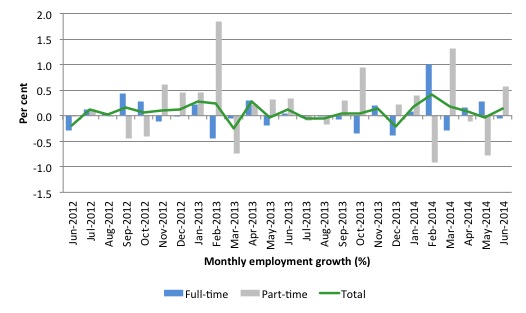
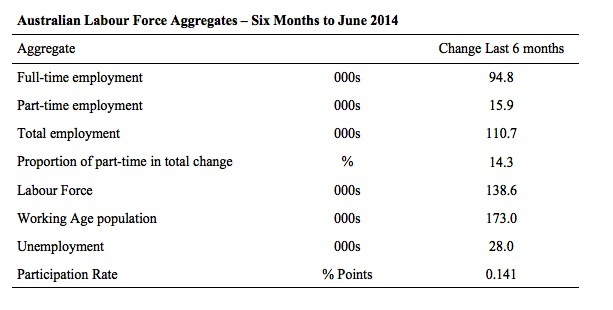
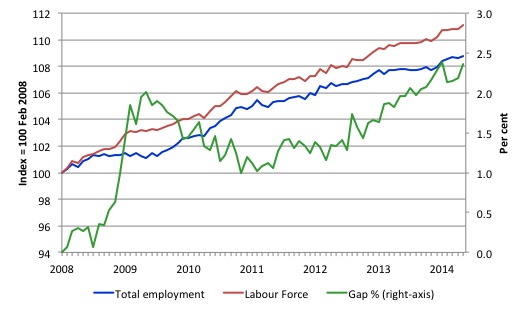
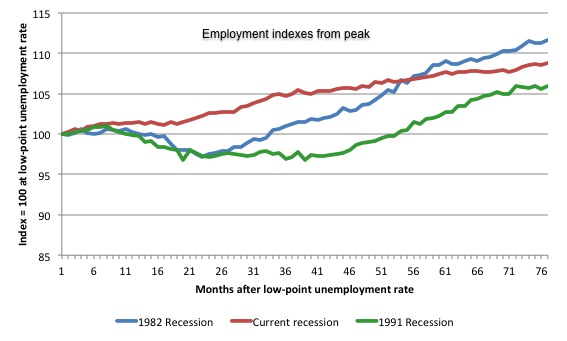

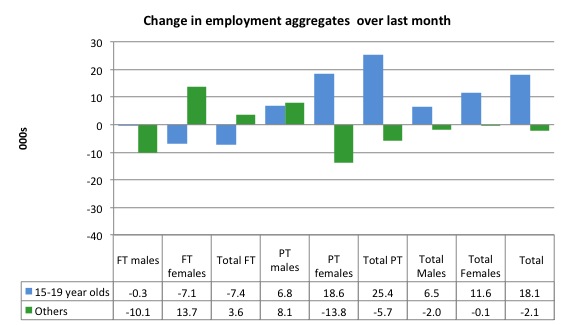
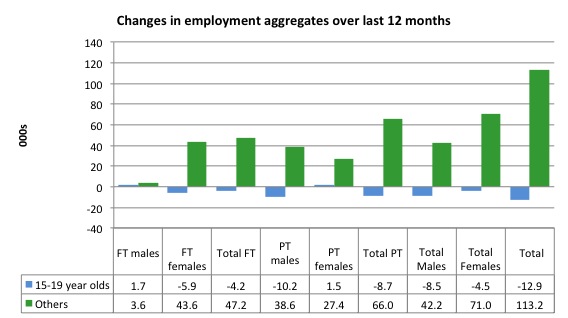
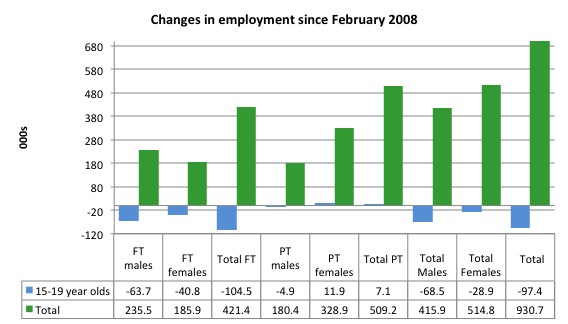
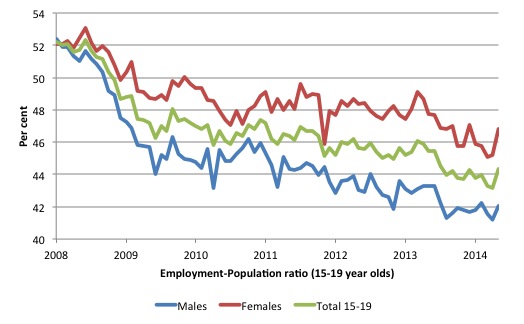
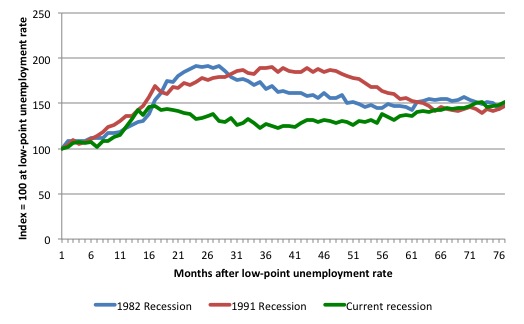

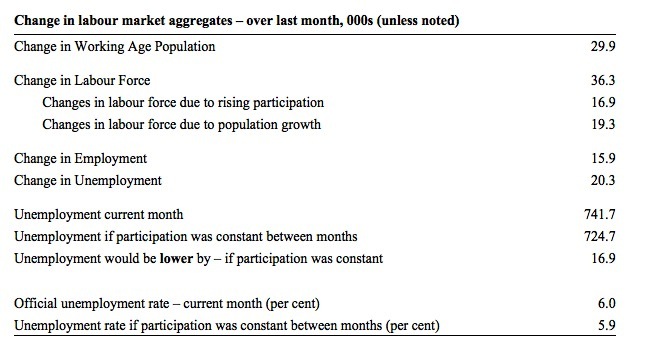
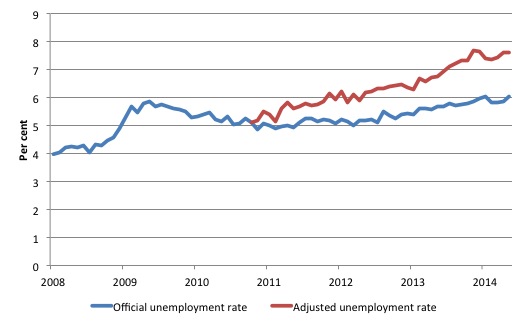
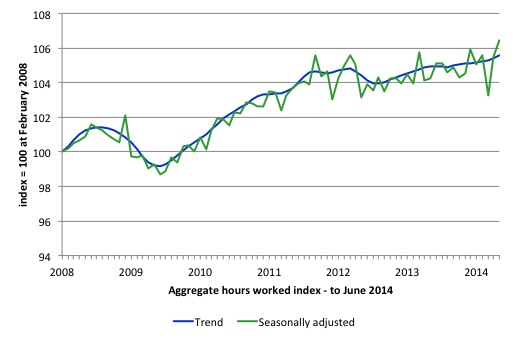
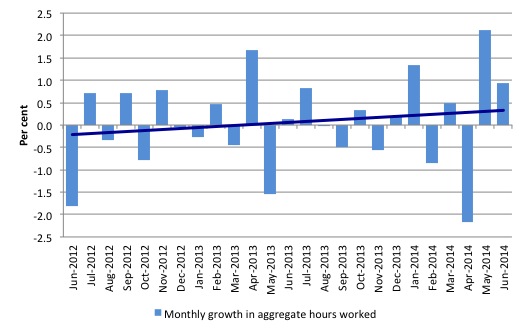
In terms of the UK labour market the Resolution Foundation has just released an interesting paper.
http://www.resolutionfoundation.org/media/media/downloads/All_accounted_for_the_case_for_an_all_worker_earnings_measure.pdf
In the UK the ONS collects data on the numbers of self-employed but does not collect data on the earnings of the self-employed. This paper has a go at incorporating self-employed earnings into the normal average earnings data. Not surprisingly they find that overall, “Including the self-employed in our most timely earnings barometer would have worsened our view of the fall in earnings since the pre-recession peak by between 20 and 30 per cent”.
I wondered if Australia incorporates the earnings of self-employed people in their statistics.